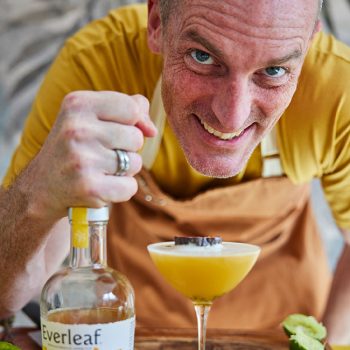SB meets… Paul Mathew, Everleaf
By Miona MadsenEverleaf non-alcoholic apéritifs were created to address the need for premium alcohol-free options on the market. We interviewed the brand’s founder to find out how Everleaf stands out for its taste and sustainability ethos.

What inspired you to create Everleaf?
I was working behind my bar, serving some of the finest spirits in the world, when someone would ask for a non-alcoholic option, but nothing had the same sense of craft or experience behind it. That moment really stuck with me. I started wondering how I could combine my knowledge of plants and spirits to create something truly special without alcohol, with the same complexity, texture, and journey on the palate.
How does your background as a conservation biologist influence the products?
My lifelong passion for plants means I have an extensive repertoire of plant ingredients from which to draw inspiration.
Two hundred thousand plant species are considered edible, and different parts of the plant may not taste the same.
That is one million different flavours and aromas to combine. The conservationist in me is also conscious of where the ingredients come from and how they are grown.
Where do you source your ingredients?
Our plants are sourced worldwide, from British strawberries and Japanese cherry blossoms traditionally fermented in Shizuoka to dulse hand-harvested on the Irish coast and sustainably grown vanilla from Madagascar. We also source bergamot from Calabria and saffron from Iran. With our flavours, we celebrate the world’s plant biodiversity and sustainability. The ingredients are blended with a base of plant gums, which gives Everleaf its distinctive texture. After blending, the liquids rest before being bottled and pasteurised.
How do you approach creating texture and layering flavour?
It all starts with our base texture, inspired by an old recipe for salep, a drink from the Eastern Mediterranean and Middle East. It was served by street sellers in London before tea and coffee took over, and was known for its thick and glutinous character, sweetened and flavoured with herbs and spices, and excellent mouthfeel.
From the flavour, I develop a flavour profile that includes a beginning, middle and end. After establishing the structure, I focus on finding ingredients that help integrate the elements into a cohesive product – an ecosystem in a bottle – creating something greater than the sum of its parts. Each expression contains at least 15 plants, but the goal is that they shouldn’t all stand out as individual flavours; instead, they should be balanced.
How much of your work has been trial and error?
Like developing a new cocktail list, there is a lot of experimentation. I would describe it as informed research and development rather than just trial and error, but a lot of it is involved. The first Everleaf, Forest, was refined over 18 months at The Hide Bar. I tested various extractions and recipes at home and brought the results in for guests to sample. For Marine and Mountain, using the Forest as a blueprint, I dedicated more than nine months to their development during the Covid-19 pandemic. While I typically have a specific flavour in mind, the way the ingredients interact can vary widely, leaving room for continuous experimentation.
What makes Everleaf stand out in the market?
I wanted Everleaf to work in the same way as other apéritifs, with sweetness and a bitterness. Forest has a unique saffron and orange blossom character, while Mountain offers savoury notes of fermented cherry blossom and rosehip. Marine highlights the umami of kelp and dulse, with the freshness of bergamot.
We are B Corp and certified carbon neutral by Climate Partner, offsetting what we can’t avoid producing through forest, mountain and marine projects. We also donate at least 1% of our turnover to plant-conservation work by the charities Fauna & Flora and Plantlife.
Related news
Everleaf sweetens pack deal for festive season
